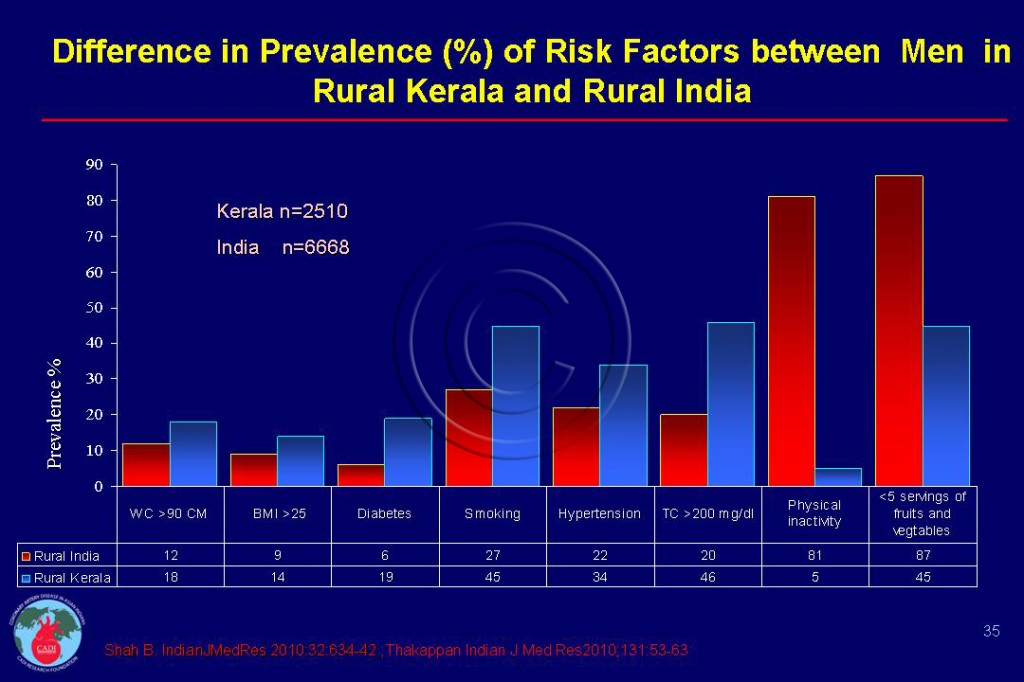Kerala Risk Factors
- The overall prevalence of risk factors is 50-100% higher in Kerala than the national average with narrower urban-rural gradient.1, 2 The difference in the prevalence of risk factors is particularly high between rural Keralans and rural Indians (Figure 035).1, 2
- Prevalence of high blood pressure is 30-36% compared to 21-30% nationally with some studies showing rates as high as 47% in some urban areas.1, 2 6 Prehypertension is also high. Both awareness and treatment of high blood pressure is low (<20%).1, 3
- Tobacco use is equally high in rural (45%) and urban (43%) Keralans with highest rates among slum dwellers (63%) but uncommon in women, consistent with cultural differences throughout India.1 Smoking in Kerala is nearly double that of national average as well as the US average.1, 2 Smoking is associated with a lower prevalence of obesity.1 However, this is not a justification not to quit smoking or to start smoking.
- Prevalence of obesity (Body Mass Index or BMI >25) is 31%. Mean BMI is higher by 2 units, waist circumference is higher by 2-5cm and obesity is 2 times more prevalent in urban men and women compared with their rural counterparts.1, 2 The urban-rural difference is much narrower than the national average.
- Keralans have the highest cholesterol level in India that ranges from 197 to 229mg/dl compared to 157 to 180mg/dl nationally which is attributable to the high intake of saturated fat from coconut meat, milk, and oil.1, 2 (see Kerala Paradox and Coconut)
- Prevalence of diabetes ranges from 11-19% in men and 15-22% in women with rural Keralans having paradoxically higher rates of diabetes than urban dwellers.1, 2 Only 20% of the diabetics are treated and adequately controlled (see Diabetes in Kerala).
- Physical inactivity is common and associated with greater prevalence of overweight, abdominal obesity and diabetes. 35-70% of Keralans do not consume 5 servings of fruits and vegetables per day compared to 80% -90% nationally.1
- As high as 50% of diabetes and high blood pressure are undiagnosed.3 The proportion of undiagnosed high cholesterol is likely to be even higher since the general practitioners are virtually excluded from testing and treating dyslipidemia.
- In one study from Trivandrum city ( n=482) 47% had high blood pressure and 42% had prehypertension but only 81 (17%) patients with high blood pressure were aware of their disease.3
- Since today’s risk factors are tomorrow’s disease, the high and escalating prevalence of risk factors portend a continuing epidemic that warrants urgent action by the medical community and all stakeholders.
Sources
1. Thankappan K R, Shah B, Mathur P, et al. Risk factor profile for chronic non-communicable diseases: results of a community-based study in Kerala, India. Indian J Med Res. Jan 2010;131:53-63.
2. Shah B, Mathur P. Surveillance of cardiovascular disease risk factors in India: the need & scope. Indian J Med Res. Nov 2010;132(5):634-642.
3. Vimala A, Ranji SA, Jyosna MT, Chandran V, Mathews SR, Pappachan JM. The prevalence, risk factors and awareness of hypertension in an urban population of Kerala (South India). Saudi J Kidney Dis Transpl. Jul 2009;20(4):685-689.


